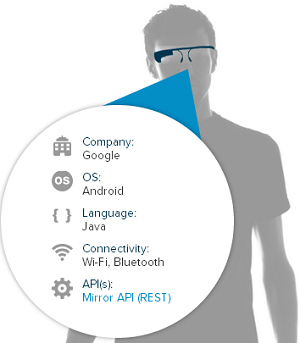News
Salesforce.com Hopes Wear Is a Fit for Mobile Developers
- By David Ramel
- June 13, 2014
Salesforce.com Inc., known for its customer relationship management (CRM) software, this week announced a developer kit for wearable devices, part of its Salesforce Wear project that it claims is "the industry's first initiative for wearable computing in the enterprise."
The Salesforce Wear Developer Pack is designed to help developers build apps to connect enterprises with customers in completely new ways through wearable devices.
The announcement -- following new guidance from Google Inc. about how developers should design apps for wearables -- is a further sign that wearable is the new mobile.
"Wearable devices represent the next phase of this mobile revolution," the company quoted Forrester Research Inc. analyst J.P. Gownder as stating in a report, "The Enterprise Wearables Journey."
"Perpetually connected wearables will enable workers, partners, and customers to experience new levels of immediacy, simplicity, and context in their mobile computing experiences," Gownder said. "Wearables aren't just a consumer phenomenon; they have the potential to change the way organizations and workers conduct business."
 The Google Glass Sample App (source: Salesforce.com Inc.)
The Google Glass Sample App (source: Salesforce.com Inc.)
The Salesforce Wear Developer Pack includes a library of open source starter apps to help developers quickly design and build wearable apps connecting to the company's Salesforce1 Platform. That platform is a collection of cloud services such as Force.com, Heroku, and ExactTarget Fuel designed to help build apps with open APIs, back-end services, tools for integration, starter templates, and developer environments.
Salesforce.com said more than 1.5 million Salesforce1 enterprise developers "can immediately access a growing library of devices, sample code, documentation, demonstrations and reference apps to learn from."
For example, the Wear Pack for Google Glass sample is the first featured app in the library. It quickly tells developers the device's company is Google, the OS is Android, the language is Java, the connectivity is Wi-Fi or Bluetooth and the API used is Mirror (REST). The Google Glass entry describes various details about the devices and how they work and provides an instructional YouTube video. It tells developers they'll need the Android SDK, the Glass Development Kit and Salesforce Developer Edition.
The sample app, hosted on GitHub, is an on-site inspection app that technicians can use to help navigate through a step-by-step inspection process of something in the field, such as a pipeline, for example. The technicians can issue voice commands to record yes/no responses in Salesforce, take photos, create trouble tickets and search support information. The app dynamically generates an inspection list based on GPS location and completed inspection steps that's stored in a custom Salesforce object.
Similar entries are available for the Android Wear OS, Samsung Gear 2 smartwatch, Myo armband, Nymi biometric identity wristband and Pebble smartwatch. Salesforce.com also said it will support other devices worn on the face, wrist, or body such as from Fitbit, OMsignal, and Phillips.
"All of these new devices have different application architectures, UX patterns and data flows," said Salesforce.com exec Adam Seligman. "The Wear Developer Pack handles the identity, secure API access and plumbing necessary to connect the device to the Salesforce1 Platform, letting the developer focus on innovative new use cases."
Those use cases, the company said, could include personalized customer services from destinations such as casinos, resorts or amusement parks; contextually aware sales apps that could, for example, let a salesperson unobtrusively check an update on a wearable rather than disrupt a meeting by opening up a laptop or checking a phone; and connections to remote technicians, such as oil rig workers or medical device representatives to provide all kinds of data and interactive communication.
"Developers will be able to create apps that connect wearable devices to any business process," Salesforce.com said. "Apps can be built for everything from a 'nudge' on a smartwatch when an urgent approval is required, to secure facilities access via a wristband, to encouraging healthy workforces through fitness challenges using fitness tracking devices."
Salesforce.com quoted an IHS white paper, "Wearable Technology - Market Assessment," that estimates some 50 million wearable devices will be sold this year, with more than 180 million sold in 2018. "With the massive number of devices coming into market, it is imperative that companies understand how consumers will operate in a hands-free world," Salesforce.com said. "Wearables are the future of mobile, and companies can now discover new ways to market, sell, service and more."
The developer pack is now generally available with all Salesforce CRM or Salesforce Platform user licenses.
About the Author
David Ramel is an editor and writer at Converge 360.